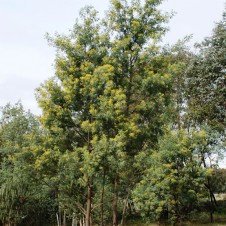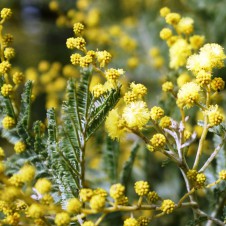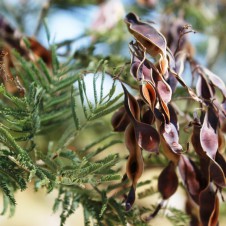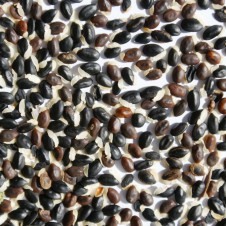



General Description: A smooth trunked tree, silvery grey or greyish green in colour. Small and spindly to 5 meters high on poorer, drier sites and a tall tree to 20 meters in high rainfall areas. Has feathery grey-green foliage and bark that is smooth, dark brown and usually blotched with grey lichens. Young small branches are often coated with wax that gives the grey or silvery appearance and at the base of each pair of pinnae is a conspicuous gland. Distinguished from A. mearnsii because it has glands between the bases.
Flowers and fruit: Flower-heads are round, pale to bright yellow in a dense arrangement along a stem. Flowers from July to October. Fruit is an oblong pod often with one or two deep constrictions but otherwise with straight-sides.
Site Preference and Tolerances: Prefers soils which are moist for most of the year, especially stream-sides. Better growth results on deep, fertile acid soils but will grow on well-drained clays. Occurs on granite, sandstone and volcanic soils. Tolerant of strong winds, frost, snow, exposed and cold sites. Tolerates a wide range of soils including clays and gravelly clays if soil drainage is adequate. Dislikes poorly drained or wet soils and regenerates well in most situations.
Life Span: Medium, 20 to 80 years.
Wildlife Value: Is a butterfly food plant providing food for caterpillars of Blue Jewel and Silky Hairstreak. It is also host to the Imperial Blue Butterfly when less than 3m high. Attracts both seed-eating and insect-eating birds. Many different species of adult beetles and their larvae feed on the foliage. The seed-stalks (funicles) of fallen seeds are sought by ants. Its gum is a favoured food source of gliders and possums.
Other Values and Uses: Fast growing source of firewood that can burn well, particularly if cut and dried before burning, standing dead timber can rot quickly.
Suckers readily from the roots and is excellent for gully erosion control. Its fast growth and ability to improve soils by adding nitrogen makes it suitable as a nurse crop for longer lived species.
The tan bark has moderate tannin content for hide or fabric tanning and is cultivated overseas for this purpose. The leaves are useful for dyeing.
Aboriginal uses included the following: wood was fashioned into stone axe handles. Sticky gum mixed with ash made a waterproof paste to seal holes in bark water vessels. Gum was eaten or dissolved and mixed with flower nectar for sweet drinks. Other similar species of Acacia may have been used in the same way.
Other Scientific Names: Racosperma dealbatum
Germination Information: Need to break seed dormancy and heat treatment using boiling or just boiled water is usually used. I prefer to pour just boiled water over the seed and leave it overnight and then plant the seeds the next morning.
